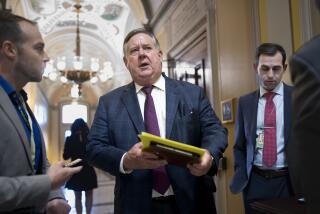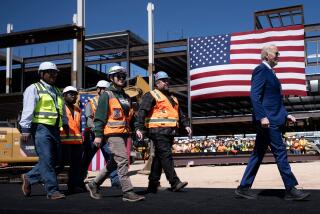Will the pork stop here?
- Share via
WASHINGTON — Incoming Senate Majority Leader Harry Reid vows to make reform of congressional earmarks a priority of his tenure, arguing that members need to be more transparent when they load pet projects for their districts into federal spending bills.
But last year’s huge $286-billion federal transportation bill included a little-noticed slice of pork pushed by Reid that provided benefits not only for the casino town of Laughlin, Nev., but also, possibly, for the senator himself.
Reid called funding for construction of a bridge over the Colorado River, among other projects, “incredibly good news for Nevada” in a news release after passage of the 2005 transportation bill. He didn’t mention, though, that just across the river in Arizona, he owns 160 acres of land several miles from proposed bridge sites and that the bridge could add value to his real estate investment.
Reid denies any personal financial interest in his efforts to secure $18 million for a new span connecting Laughlin with Bullhead City, Ariz.
“Sen. Reid’s support for the bridge had absolutely nothing to do with property he owns,” said Rebecca Kirszner, Reid’s communications director. “Sen. Reid supported this project as part of his continuing efforts to move Nevada forward.”
But some Bullhead City property owners and local officials say a new bridge will undoubtedly hike land values in an already-booming commuter town, where speculators are snapping up undeveloped land for housing developments and other projects. Experts on congressional spending say Reid’s earmark provides yet another sign of the need for reform.
“It’s a really bad idea for lawmakers to earmark projects when they have a financial interest that could in any way be affected by it,” said Norman Ornstein, coauthor of “The Broken Branch” a recent book that examines earmarking and other practices.
Ornstein said he did not have enough information to fully evaluate the Reid deal. But, he said, “we already have too many examples — including a number of Southern California representatives — who are very directly using this process to enrich themselves.”
Said Steve Ellis, vice president of Taxpayers for Common Sense, a nonpartisan watchdog that tracks congressional spending, “Unwittingly, the taxpayer may have helped inflate the value” of Reid’s property.
Earmarking allows congressional leaders, committee chairs and other insiders to insert narrowly targeted spending orders into pending legislation without going through the normal budget review process. Members of both parties defend earmarking as a way for Congress to get attention for local concerns when executive-branch agencies are unresponsive.
Earmarking was at the heart of the case against former Rep. Randy “Duke” Cunningham (R-Rancho Santa Fe), now in prison for using his congressional seat to secure federal funding for individuals who provided him personal benefits. It was also the basis for much of the wealth amassed by criminal lobbyist Jack Abramoff, who referred to the appropriations committee as “the favor factory.”
Reform has been difficult to achieve in part, critics say, because leaders of both parties encourage earmarking to build popularity at home and power among fellow Congress members.
Reid is not the only powerful member known to use the practice. Incoming House Speaker Nancy Pelosi, a former appropriations panel member, has used earmarks prodigiously.
The minority leader of the new Senate, Mitch McConnell (R-Ky.), is an active earmarker, as is current Speaker J. Dennis Hastert (R-Ill.), who last year secured funding for a highway interchange near property he owned outside Chicago. (He too has claimed there is no connection between his earmarks and personal land holdings.)
Last week, when Reid’s status rose as Democrats took control of the Senate after the midterm election, the senator promised, like Pelosi, to make earmark reform a top priority when party members caucused.
“With Democrats running Congress, we are in a much better position to achieve real transparency and openness,” said Kirszner.
In earlier years, Reid has boldly claimed credit for getting earmarks for his constituents. Last year, he boasted of securing $300 million in earmarks in the transportation bill.
When pressed about his position on earmarks in an interview on public television in January, Reid acknowledged abuses, but added: “There’s nothing basically wrong with earmarks. They’ve been going on since we were a country.”
Actually, earmarks have skyrocketed in recent years, from 1,439 in 1995 to 15,268 last year, according to a Senate estimate.
The proposed bridge between Laughlin and Bullhead City was not on the priority list sent to local members of Congress by either the Nevada or Arizona transportation agencies.
But beginning in 2003, local supporters of the bridge — which would be the second span connecting the two towns — found a receptive audience when they approached some members of the Nevada and Arizona congressional delegations. Civic leaders argued that an additional bridge was needed because traffic on the existing connector bridge, on the northern edge of Bullhead City, had become overwhelming.
Laughlin consists mainly of casinos and hotels, and has little housing or shopping. Most of the casino workers live across the river in Bullhead City, which also has shopping and a hospital. Elected officials say both communities would benefit from a second bridge.
Reid’s land, three to five miles from several proposed sites for the second bridge and near the local hospital, is undeveloped. New housing is springing up around it.
Acting on a request from the town of Laughlin, Reid, a member of the Senate Appropriations Committee’s transportation subcommittee, in 2003 secured $500,000 for preliminary studies.
Last year, Rep. Jon Porter (R-Nev.), supported by Rep. Trent Franks (R-Ariz.), got $2 million for the bridge inserted into the House version of the transportation bill.
By the time Congress approved the $286-billion transportation bill, $18 million more in bridge funding had been added. Reid took credit in a news release for securing money that would kick the project into high gear. The bridge, still in the planning stages, is projected to cost $30 million to $40 million.
Arizona’s two Republican senators voted against the entire transportation bill as pure pork.
Nowhere in Reid’s statements about the project was any mention of his Bullhead City land holdings; he does list it on his Senate financial disclosure forms. He valued the Arizona land at $500,000 to $1 million in his most recent disclosure, which reported total assets of at least $2.2 million.
Reid’s interest in the Arizona land dates back more than 20 years and, according to his staff, has been a long-running headache. He paid about $150,000 for 100 acres of the Bullhead City parcel, and his longtime friend Clair Haycock bought the remaining 60 acres for $90,000.
Californians who bought the property from the two in the early 1990s defaulted on a $1.3-million note and returned the land to Reid and Haycock.
In early 2002, Haycock sold out to Reid for $10,000, or about $166 an acre.
At the time, the Mohave County assessor valued the entire parcel at $339,620, or more than $2,000 an acre.
The low price resulted from Haycock’s need to sell and Reid’s lack of interest in buying, the two men said.
The investment “had been a losing proposition for about a decade running,” Reid’s staff said.
Haycock, who owns Haycock Petroleum Co. of Las Vegas, said in an e-mail that he needed to sell his share to liquidate a company pension plan, which owned the property.
He said in a statement that he “expected nothing from Sen. Reid” in return for selling him the property.
“Sen. Reid has never taken any official action to provide personal financial benefit to me, and I would never have asked,” Haycock said.
City and county officials say that land values have been rising in Bullhead City as developers and speculators discover the area.
“Once they build a bridge, values will go up,” said Frank Capotosto of the Mohave County assessor’s office.
“A new bridge will increase value because there would be better circulation, “ said Pawan Agrawal, public works director and city engineer for Bullhead City.
“A lack of a bridge depresses our growth.”
California businessman Ken Renfroe recently bought property near Reid’s that he intends to develop in five years or so. He believes that a new bridge will increase property values.
“I am sure it has already had a positive influence,” he said of the proposal.
He paid $240,000 for 37.52 acres, an average of $6,396 an acre, records show.
Some other local real estate owners, however, question whether the bridge would increase land values.
Reid’s office referred inquiries about land values to developer Robert Bilbray, a Reid supporter who works in the LaughlinBullhead City area.
Bilbray disputed the notion that Reid could stand to gain from the bridge construction.
Site plans have not been finalized, he said, and some proposed locations could decrease Reid’s property value.
“The concept that Sen. Reid’s property in Bullhead City, Ariz., will gain in value from another bridge between Bullhead City and Laughlin is ludicrous,” he said.
More to Read
Sign up for Essential California
The most important California stories and recommendations in your inbox every morning.
You may occasionally receive promotional content from the Los Angeles Times.










